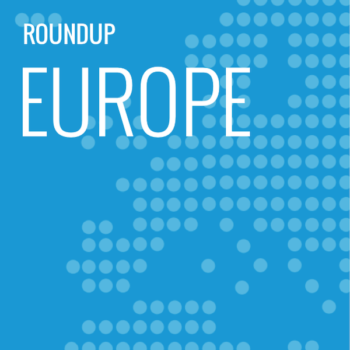Triton Digital Takes Audio Marketplace to South Africa; Captify Expands to Spain
by Sonja Kroll on 22nd Dec 2017 in News

ExchangeWire rounds up some of the biggest stories in the European digital advertising space. In this week’s edition: Triton Digital partners with South African 365 Digital; Captify expands to Spain; Bitposter collaborates with OOH Yes; Lotame integrates Nordics data; Independent audit of OOH data at JCDecaux; and Massive growth for FastPay.
Triton Digital takes programmatic audio to South Africa
A partnership with South African digital publisher solutions company, 365 Digital, brings Triton Digital’s programmatic audio marketplace, a2x, to South Africa in an effort to promote the advantages of digital audio. According to the release, 365 Digital will utilise the a2x tools for non-skippable audio buys across audiences of podcasts, broadcast radio streams, online games, sports, and online music services. The inventory served in a2x can be bought via various DSPs, including MediaMath, The Trade Desk, AudioTrade, RTBiQ, and AppNexus.
“We are proud to partner with 365 Digital to fuel programmatic audio in South Africa”, said Benjamin Masse, managing director, market development and strategy at Triton Digital. “We look forward to working with them to provide publishers and advertisers throughout South Africa with the tools and support they need to connect with new and engaged audiences in a meaningful way.”
Captify expands to Spain
Captify ticks another capital city off its list. The search intelligence provider has just announced the opening of their Madrid office. The expansion to Spain comes on the back of Captify’s growth in 2017. According to the company, business grew by 134%.

Dominic Joseph, CEO & Co-Founder, Captify
Operations in Spain will be headed up by Captify’s newly appointed VP of Europe, Vincent Pelillo. Formerly the MD of Captify Paris, Pelillo will oversee the launch of Spain and its operations and drive further expansion into other EU cities.
Dominic Joseph, CEO and co-founder, Captify, comments: "Truthfully, the launch into Spain has been accelerated due to industry demand from our global agency partners. It’s also an interesting market for us as we test the waters in South America too.”
Strategic partnership between Bitposter & OOH Yes
OOH Yes specialises in planning and buying for OOH. Now the company is announcing a strategic relationship with Bitposter, the OOH media-trading platform. As part of the collaboration, the Bitposter platform will be integrated into OOH Yes’s planning and buying toolkit.
So, how does this strategic partnership benefit Bitposter? Craig Mytton, chief revenue officer, Bitposter, tells ExchangeWire that their “technology is removing the legacy barriers and making OOH media more accessible to everyone. By using Bitposter technology, our partners are able to deliver transparency to their clients and leverage new and improving targeting opportunities for clients to maximise their return on investment. We’re looking forward to a long relationship with OOH Yes and other like-minded businesses looking to make the most of the great opportunities OOH provides today and in the future.”

Craig Mytton, CRO, Bitposter
Speaking of which – where does Bitposter see OOH heading in 2018? “The recent Magna Global Report revealed OOH and TV will be the only offline media to grow in 2018. Driving this growth is the investment media owners are putting into digital screens, which will continue into 2018. Agencies are then using these screens to deliver intelligent campaigns leveraging new functionality within OOH, like time-of-day targeting, vehicle and facial recognition, data feeds, and geotargeting for moving media.”
New advertisers will also be attracted by new trading models and technology “which reduce the barriers to entry, makes OOH more efficient, easy to purchase, and transparent”, Mytton says.
“Those best-placed to take advantage of this digital and technology revolution within OOH are digital agencies that are sitting on a wealth of customer and location data. Not only can they use online media to test and inform OOH planning and buying, but they can also use online data to provide performance metrics for OOH campaigns. Fast-evolving OOH is set to become increasingly popular in 2018, as technology continues to break down barriers and drive innovation within this media.”
Lotame partners with AudienceProject for Nordic markets
A strategic collaboration between martech providers AudienceProject and DMP Lotame will make the AudienceProject data available for Lotame’s Nordic clients. AudienceProject provides segments on the basis of more than 180 million profiled device cookies, including sociodemographic segments based on affinity as well as intent, ownership, lifestyle, and family lifecycle segments.
Initially, AudienceProject’s data is available in Lotame’s DMP for clients in Denmark, Sweden, Norway, and Finland, enabling targeting against AudienceProject’s segments. “By offering AudienceProject data inside Lotame’s DMP, we further improve access to a valuable source of high-quality data across the Nordics”, says Chris Hogg, managing director for Lotame EMEA.

Chris Hogg, MD EMEA, Lotame
ExchangeWire asked Hogg how the Nordics differ from other markets. “First, within regional markets, like the Nordics, scarcity of data is still an issue that has slowed advancements in data within advertising and marketing. This is why the need for consortiums – competitive and complementary organisations that work together – will be necessary to drive a single point of scale”, explains Hogg. “On top of that, data quality is a must and needs to be prioritised. In other markets, scale can overcome data inconsistencies. But in the Nordics, quality and recency will be critical. To generate a 360-degree view of the population through modeling, verified and accurate data-sets are table stakes. Overall, in 2018, to deliver on and ensure data quality, the adoption of data mining and artificial intelligence will be key.”
First DOOH audit for JCDecaux
As a reaction to the advertising industry calling for more transparency, JCDecaux recently commissioned PwC to independently audit the end-to-end process of JCDecaux’s proprietary media planning and booking platform, SmartBRICs, for the three months ended 30 September, 2017.
Spencer Berwin, co-CEO, JCDecaux UK, explains why the independent audit is an important milestone: “This is a crucial step in JCDecaux’s digital development and DOOH as a whole. We’ve been very open about our objective to provide a brand-safe environment for advertisers and agencies to operate in, as outlined in our manifesto, BranDO, and we want to ensure DOOH doesn’t make the same mistakes that digital online has. BranDO is all about putting the brand first by offering up guidelines on verification, measurement, brand safety, and accountability. PwC’s independent audit shows that we are serious about this commitment and we hope that the whole outdoor sector agrees with these measures as we work towards a better future for the industry.”
“Now that our audit is finalised, any advertiser or brand whose campaign is fully managed through SmartBRICs can do so with confidence that its campaign results are being reported completely and accurately, says Sam Tomlinson, partner and leader of PwC’s Media Insight & Assurance team. The audit covers JCDecaux’s delivery and reporting of UK digital campaigns.
FastPay grows with the digital industry
Global fintech player FastPay has lent more than USD$2bn (£1.5bn) to digital companies since 2009. The provider of capital and payments solutions for digital businesses says that their lending figure has doubled in the last year.
Matt Byrne, UK director, FastPay says: “This year, we have observed a surge in high-growth digital media businesses seeking working capital. More and more clients use financing to enable expansion into international markets. If a business’s revenue is doubling or more every year, many banks and high street lenders can be unwilling or simply too slow to offer the level of required finance. Whilst there is still investment going into digital businesses, the focus has switched towards marketing tech and subscription-based businesses, making typical media companies less attractive for VCs seeking scalable business models and higher returns.”
FastPay received strategic investment last year from Citi Ventures and Hitachi Capital, which has been earmarked to further develop their products. Some of the investment also went into FastPay’s acquisition of e-payment solutions provider, AnchorOps.
FastPay attributes its rapid growth to the decline of venture funding in ad tech due to a loss in investor confidence. Additionally, business lending from banks and traditional lenders has slowed down as their underwriting methods and credit policies fail to keep up with the evolving business models of the industry – creating a niche that FastPay has filled.







Follow ExchangeWire